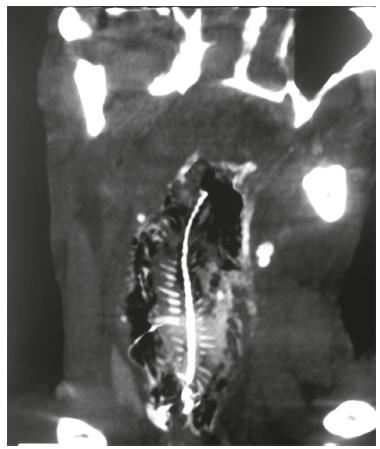INTRODUCTION
The foreign body ingestion is common in emergency services. In most cases, it passes through the gastrointestinal tract spontaneously and does not cause any considerable damage. When the impaction occurs in the gastrointestinal tract, the most common level is the upper third of the esophagus. Approximately 10-20% of the cases requires endoscopic intervention and less than 1% needs some surgical procedure44. Hachimi-Idrissi S, Corne L, Vandenplas Y. Management of ingested foreign bodies in childhood: our experience and review of the literature. Eur J Emerg Med 1998;5:319-23.,55. Zhao-Shen Li, MD, Zhen-Xing Sun, MD, Duo-Wu Zou, MD, Guo-Ming Xu, MD, Ren-Pei Wu, MD, Zhuan Liao, MD. Endoscopic management of foreign bodies in the upper-GI tract: xperience with 1088 cases in China. Volume 64, No. 4: 2006 GASTROINTESTINAL ENDOSCOPY. Usually, children from six months to six years old are more likely to that33. Eisen GM, Baron TH, Dominitz JA, et al. Guideline for the management of ingested foreign bodies. Gastrointest Endosc 2002;55:802-6.. In adults, it is more common in individuals with psychiatric disorders, drug users, alcoholics or individuals that benefit from incident, as prisoners.
CASE REPORT
Male, 52, alcoholic and user of crack, previously healthy. Accidentally swallowed a Soy fish of approximately 15 cm. It quickly progressed with hematemesis and respiratory failure before medical care. At the emergency room, it was observed respiratory arrest, being promptly intubated and laryngoscopy displayed the foreign body to the cervical esophagus. He was subjected to mechanical ventilation and remained hemodynamically stable. Endoscopy was performed soon after stabilization, but without success due to an intense inflammatory process and total occlusion of the esophageal lumen by the foreign body. Cervical and thoracic computed tomography showed the whole fish on cervical esophagus (Figure 1). The patient was submitted to surgical treatment with cervicotomy and esophagotomy, removal of the fish intact and primary synthesis of esophagus with Penrose drainage (Figure 2). He evolved without complications in surgical aspect, but with myoclonus and minimum response to the existing neurological deficit, resulting from a long period of pre-hospital cerebral hypoxia.
Coronal computed tomography of the neck clearly showing the fish impacted in cervical esophagus
DISCUSSION
The greater part of foreign bodies (80%) pass through the gastrointestinal tract without difficulties, but 20% can obstruct the lumen, requiring endoscopic or surgical removal (1% of cases). As the esophagus is a narrow portion of the gastrointestinal tract, 28-68% objects are found in this region55. Zhao-Shen Li, MD, Zhen-Xing Sun, MD, Duo-Wu Zou, MD, Guo-Ming Xu, MD, Ren-Pei Wu, MD, Zhuan Liao, MD. Endoscopic management of foreign bodies in the upper-GI tract: xperience with 1088 cases in China. Volume 64, No. 4: 2006 GASTROINTESTINAL ENDOSCOPY. The symptoms depend on the location. Dysphagia, odynophagia and salivation suggest esophageal foreign body44. Hachimi-Idrissi S, Corne L, Vandenplas Y. Management of ingested foreign bodies in childhood: our experience and review of the literature. Eur J Emerg Med 1998;5:319-23.. It can also present chest pain, cough, dyspnea, wheezing or stridor. In more severe cases, particularly in large or sharp foreign bodies, there may be intense pain, vomiting, refusal to eat, saliva ink with blood or shock11. Arana A, Hauser B, Hachimi-Idrissi S, Vandenplas Y. Management of ingested foreign bodies in childhood and review of the literature. Eur J Pediatr. 2001;160(8):468..
A medical review of database present several accidents involving foreign bodies ingestion, including food-bolus impactions, coins, fish bones, dental prostheses, chicken bones, iron slices, lighters, little metallic foreign bodies, toothbrushes, needles, and spoons55. Zhao-Shen Li, MD, Zhen-Xing Sun, MD, Duo-Wu Zou, MD, Guo-Ming Xu, MD, Ren-Pei Wu, MD, Zhuan Liao, MD. Endoscopic management of foreign bodies in the upper-GI tract: xperience with 1088 cases in China. Volume 64, No. 4: 2006 GASTROINTESTINAL ENDOSCOPY, but no reports involving the ingestion of whole fish. Impaction events with fish bones includes 12.6% of the accidents, the third highest in incidence55. Zhao-Shen Li, MD, Zhen-Xing Sun, MD, Duo-Wu Zou, MD, Guo-Ming Xu, MD, Ren-Pei Wu, MD, Zhuan Liao, MD. Endoscopic management of foreign bodies in the upper-GI tract: xperience with 1088 cases in China. Volume 64, No. 4: 2006 GASTROINTESTINAL ENDOSCOPY. As the majority of the bodies are radiopaque, the diagnosis can easily be done with plain radiography in posteroanterior and lateral projections. Endoscopy and contrasted study are needed in the case of radiotransparent objects. In all radiological exams it must be looked for signs of subcutaneous emphysema, which indicates drilling33. Eisen GM, Baron TH, Dominitz JA, et al. Guideline for the management of ingested foreign bodies. Gastrointest Endosc 2002;55:802-6.. The treatment of choice is the endoscopic removal of the foreign body, which is successful with little or no complications for the patient22. Brady PG. Esophageal foreign bodies. Gastroenterol Clin North Am 1991;20(4):691-701. The surgical treatment should be performed when endoscopic management is not possible to solve the problem, or if there is impairment of progression in the gastrointestinal tract or complications such as perforation, obstruction and bleeding22. Brady PG. Esophageal foreign bodies. Gastroenterol Clin North Am 1991;20(4):691-701,33. Eisen GM, Baron TH, Dominitz JA, et al. Guideline for the management of ingested foreign bodies. Gastrointest Endosc 2002;55:802-6..
REFERENCES
-
1Arana A, Hauser B, Hachimi-Idrissi S, Vandenplas Y. Management of ingested foreign bodies in childhood and review of the literature. Eur J Pediatr. 2001;160(8):468.
-
2Brady PG. Esophageal foreign bodies. Gastroenterol Clin North Am 1991;20(4):691-701
-
3Eisen GM, Baron TH, Dominitz JA, et al. Guideline for the management of ingested foreign bodies. Gastrointest Endosc 2002;55:802-6.
-
4Hachimi-Idrissi S, Corne L, Vandenplas Y. Management of ingested foreign bodies in childhood: our experience and review of the literature. Eur J Emerg Med 1998;5:319-23.
-
5Zhao-Shen Li, MD, Zhen-Xing Sun, MD, Duo-Wu Zou, MD, Guo-Ming Xu, MD, Ren-Pei Wu, MD, Zhuan Liao, MD. Endoscopic management of foreign bodies in the upper-GI tract: xperience with 1088 cases in China. Volume 64, No. 4: 2006 GASTROINTESTINAL ENDOSCOPY
-
Financial source: none
Publication Dates
-
Publication in this collection
Jan-Mar 2016
History
-
Received
16 Apr 2014 -
Accepted
12 Jan 2016



